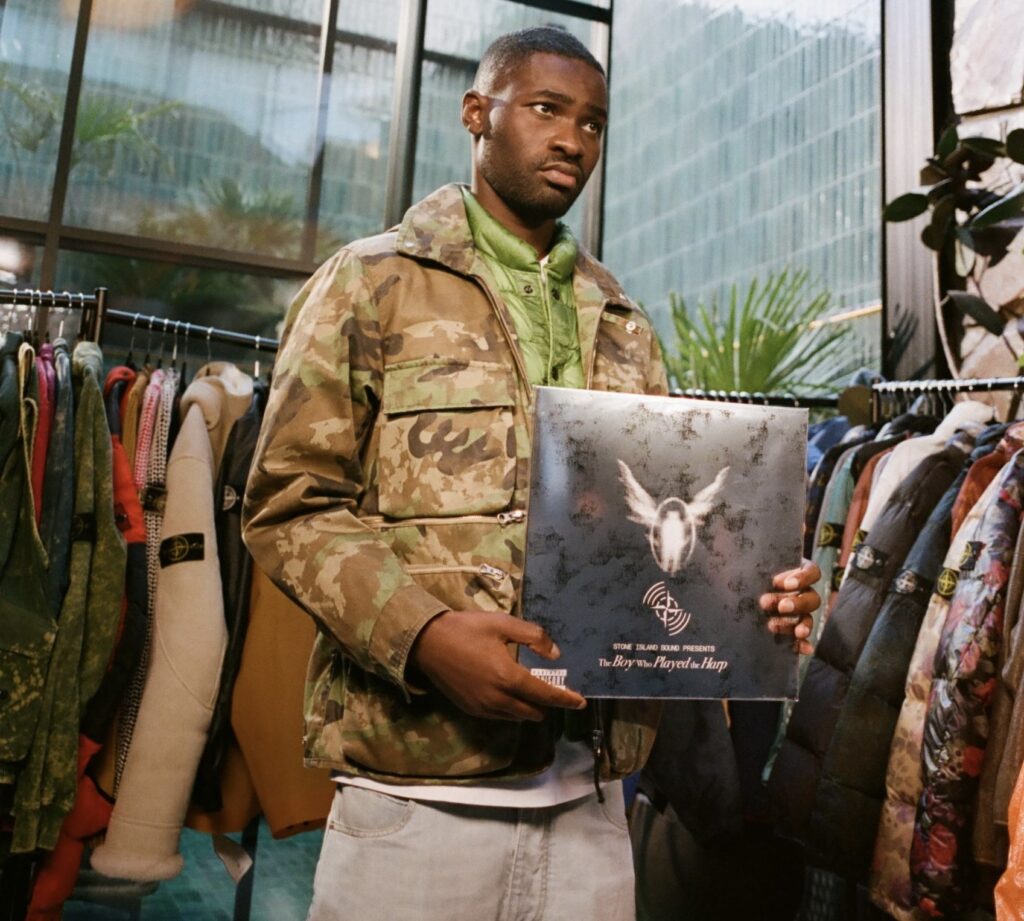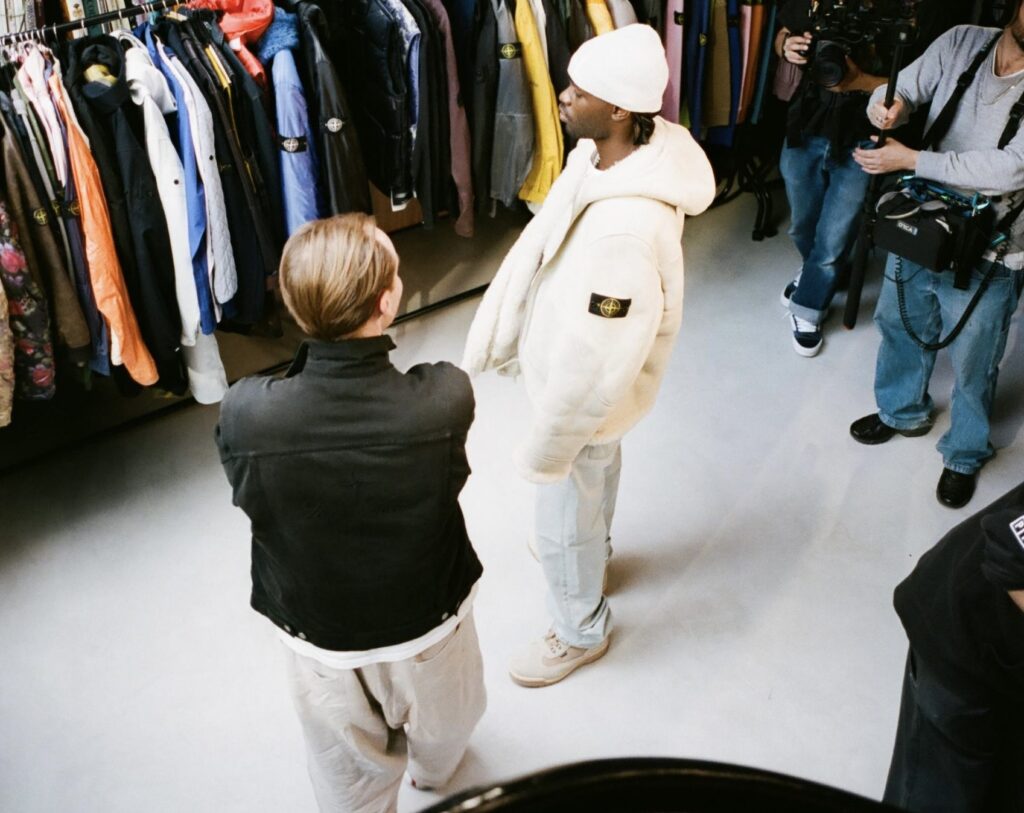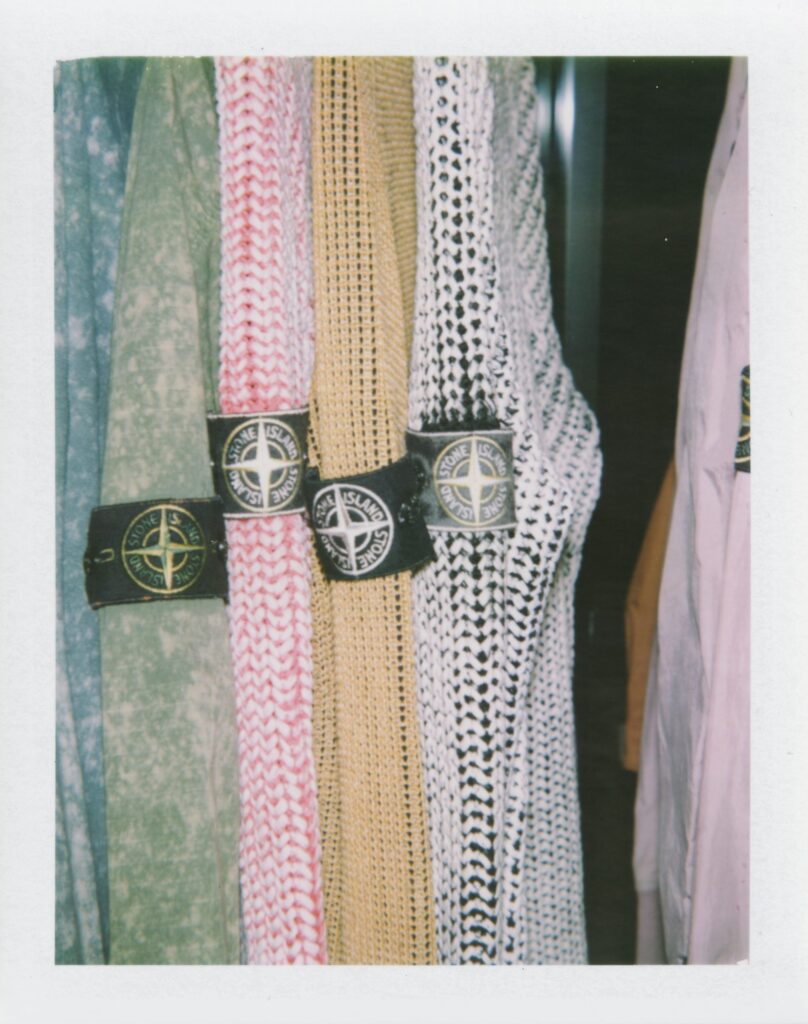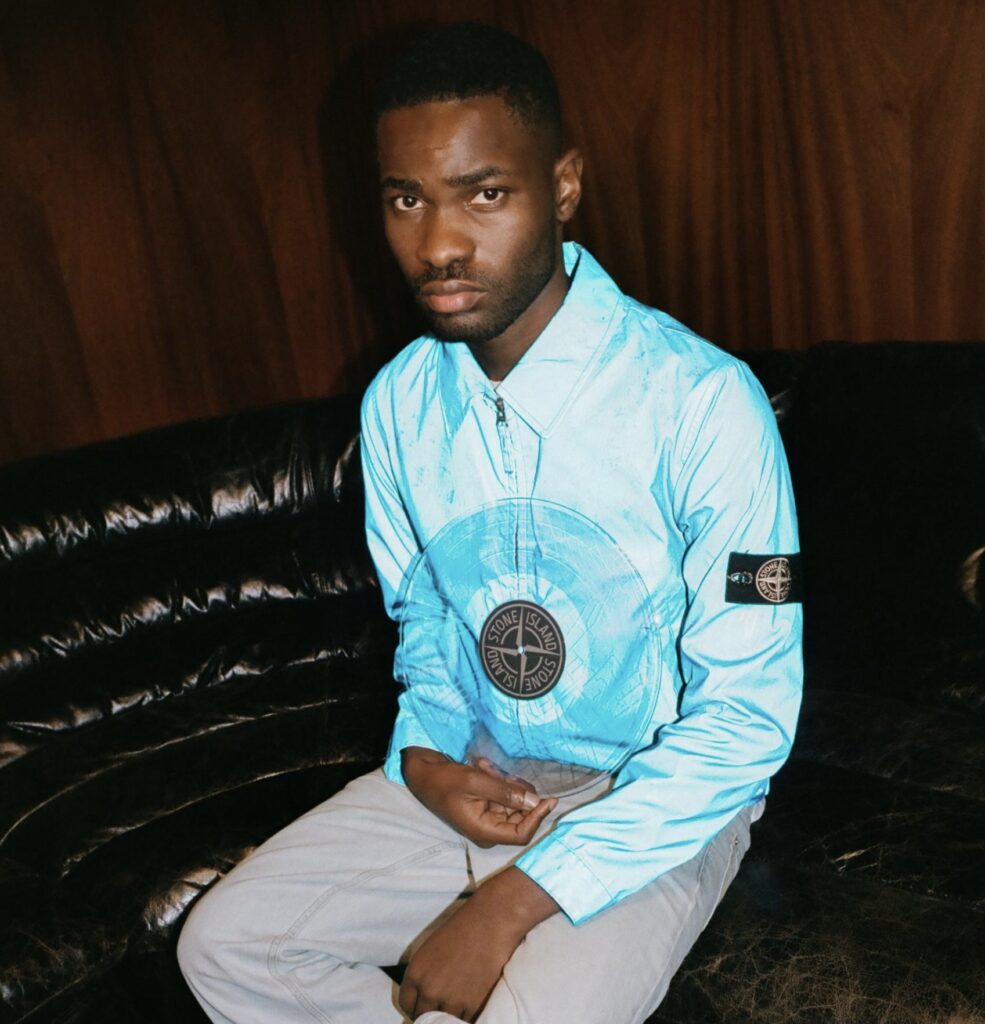this is more than fashion.
There are connections that make sense, and then there are those that feel inevitable — as if they’ve existed in parallel all along, waiting for the right alignment to surface. Stone Island’s partnership with British musician Dave for the release of his new album, The Boy Who Played The Harp, belongs firmly to the latter.
The union feels less like a marketing campaign and more like the natural expression of mutual philosophy. Both entities — the brand and the artist — operate at the intersection of authenticity, craft, and cultural depth. Both build from the inside out, layering meaning beneath surface aesthetics. Together, they present a collaboration that redefines what fashion’s relationship with music can be: not sponsorship, not synergy, but solidarity.
a brand that speaks in texture
Stone Island has always been a language of material rather than logo. Since its founding in 1982 by Massimo Osti, the Italian label has stood as a touchstone for innovation — weaving technical research with visual simplicity. The brand’s legacy was not built through mass marketing or celebrity endorsement but through obsession: the obsessive pursuit of new fabric treatments, dyeing techniques, and forms of functional expression.
This tactile experimentation became a visual code. For decades, subcultures from football terraces to underground collectives used Stone Island as shorthand for authenticity — a garment that meant something beyond fashion. The badge on the sleeve wasn’t status; it was membership.
So when the brand chose to collaborate with a musician, it wasn’t simply about soundtracking style. It was about returning to the idea that cultural resonance begins with real people — those who live in the clothes, move through the streets, and tell their own stories through the garments they wear.
enter Dave — the boy who played the harp
Dave’s journey has always been more symphonic than linear. From the first notes of Psychodrama to the introspective crescendos of We’re All Alone in This Together, his music has walked the line between introspection and spectacle. His lyricism — deeply personal yet politically awake — reveals the mind of an artist both grounded and visionary.
The Boy Who Played The Harp arrives not as another chapter, but as an evolution of tone. The title itself reads like a myth or fable — a story of sound and solitude, of music as instrument of truth.
Stone Island’s involvement in this release does not dilute that authenticity; it frames it. The collaboration celebrates the link between creativity and craft — the same meticulous approach that defines a well-cut jacket or a verse layered in metaphor.
the short film — dialogue btw memory and material
To mark the album’s release, Stone Island has produced a short film that serves as both documentary and confession. In it, Dave sits down with Arco Maher — archivist, curator, and a long-standing figure in the brand’s cultural universe. Maher’s archive is legendary, spanning decades of Stone Island’s most iconic pieces: prototype outerwear, rare dye experiments, and garments that trace the label’s constant evolution.
As the two speak, the conversation drifts between memory and material — from the emotional weight of a song to the patina of a worn jacket. Each piece Dave picks up carries not only fabric but experience: nights spent recording, city walks between gigs, moments of solitude where music and silence meet.
The visual tone of the film mirrors Stone Island’s identity: subdued lighting, muted tones, a feeling of intimacy. There are no product shots or glamourized frames — only gestures, pauses, and the quiet hum of conversation. It’s less an advertisement and more a study in resonance.
View this post on Instagram
an archive of emotion
In the dialogue, Dave reveals that Stone Island has long been a companion to his journey. The garments, he explains, were never curated for image but collected for feeling. “I’ve always worn what felt real,” he says in one moment, “and Stone Island was always a part of that.”
His personal collection — showcased in fragments throughout the film — tells the story of evolving identity. Early utility jackets from his first tour. Washed cotton overshirts from his studio days. Weatherproof shells from nights spent crossing continents. Each item becomes a timestamp, a wearable diary that documents both artistic and personal growth.
In this way, the collaboration transcends mere aesthetics. It becomes an act of preservation — an acknowledgment that fashion can be autobiography.
the limited edition vinyl
Alongside the film and album release, Stone Island has issued a limited edition vinyl of The Boy Who Played The Harp. It is more artifact than merchandise — a physical embodiment of the partnership’s shared ethos.
The vinyl, pressed in high fidelity and encased in minimal matte packaging, is available exclusively at Stone Island flagship stores in London, New York, and Tokyo, as well as through Dave’s official website. Each copy arrives with a hand-numbered sleeve and an insert featuring stills from the film — a tangible bridge between sound and vision.
For collectors, it marks the rare convergence of music and design integrity. For fans, it is a reminder that art, when released into the world, deserves to be held, not just streamed.
the stone island sound initiative
This collaboration didn’t materialize in isolation. It is the natural progression of the brand’s ongoing Stone Island Soundproject — an initiative launched in partnership with British independent label A-TON to explore the symbiosis between contemporary music and visual identity.
Curated playlists, experimental releases, and cross-disciplinary performances have defined the project’s ethos. By giving a platform to both emerging and established artists, Stone Island Sound functions as a living archive of cultural rhythm — one that echoes the same values of experimentation and authenticity found in the brand’s textile laboratories.
In bringing Dave into this fold, Stone Island reinforces that sound is a form of craftsmanship. The process of layering frequencies mirrors the process of layering fabric. Both disciplines require intuition and control, imagination and discipline — qualities that define both a well-constructed song and a well-constructed jacket.
further
“More than fashion” has become a common refrain in the industry, but few brands embody it as concretely as Stone Island. This collaboration with Dave solidifies the label’s position not as a fashion brand but as a cultural institution.
Where many luxury houses have chased ephemeral collaborations for relevance, Stone Island’s approach feels timeless. It does not chase culture; it nurtures it. By aligning with artists whose integrity mirrors their own, the brand extends its reach beyond commerce into creative mentorship and preservation.
In this sense, The Boy Who Played The Harp becomes more than an album — it becomes a cultural blueprint for how fashion can act as patron rather than parasite.
sound as material, material as sound
There’s a tactile quality to Dave’s music — an almost physical density in the way his words occupy space. Similarly, Stone Island’s garments have always been tactile narratives. Every weave, every dye, every fold tells a story about time and transformation.
In this collaboration, those narratives intertwine. The sound of strings brushing against fingertips, the breath between lines, the friction of fabric against skin — all become part of a single sensory experience.
The accompanying visuals echo this synthesis. Close-ups of textile textures cut against the strum of the harp, sound dissolving into surface. The result is immersive, grounding the album’s ethereal tone in something profoundly human.
the harp as metaphor
The harp, both literal and symbolic, threads the project together. In mythology and music alike, the harp represents clarity — the pure sound of thought made audible. For Dave, it becomes an emblem of vulnerability and control, of tradition and innovation.
Stone Island’s choice to highlight the harp aligns with its own aesthetic values: minimal, exacting, and steeped in history. The instrument, like the brand, resists trend; it belongs to an ongoing dialogue between craft and emotion.
Within the short film, the harp appears not as spectacle but as presence — a quiet witness to conversation. Its strings hum beneath the rhythm of words, like fabric beneath the skin.
culture
What Stone Island and Dave have achieved here suggests a new model for creative partnerships. The collaboration is not promotional but participatory — each side contributing substance, not surface.
In a landscape oversaturated with fleeting brand tie-ins, this project reasserts the value of genuine cultural exchange. It demonstrates that fashion’s highest purpose may no longer be to sell clothing, but to sponsor context — to fund and frame the stories that shape collective consciousness.
Through The Boy Who Played The Harp, Stone Island does not sell jackets; it sells reflection, introspection, connection.
global reach, local Roots
Though global in distribution, the collaboration retains a strong sense of place. The cities chosen for the vinyl release — London, New York, Tokyo — are not random markets; they are cultural capitals where both Dave’s music and Stone Island’s aesthetic hold deep resonance.
In London, the partnership feels particularly poetic. Both entities emerged from the streets, from communities that prized authenticity over artifice. The imagery of the short film — grey skies, concrete tones, studio interiors — feels like an ode to this shared origin.
In Tokyo and New York, the project takes on a new texture: cross-cultural dialogue. It becomes a reminder that artistic language, whether textile or lyrical, is universally intelligible.
the aesthetics of restraint
There’s an understated beauty in how this collaboration presents itself. No theatrics, no exaggerated branding, no forced fusion. The design of the campaign — from the vinyl’s minimalist sleeve to the film’s muted cinematography — reflects a shared discipline between Dave and Stone Island.
Both understand that restraint amplifies emotion. The quietest gesture can carry the deepest resonance. The boy plays the harp; the world listens.
In an era defined by overstimulation, Hinoki-like calmness (to borrow from the serenity of Japanese minimalism) becomes revolutionary.
impression
Collectors have long recognized Stone Island garments as artifacts of design innovation. This collaboration extends that logic to sound. The limited edition vinyl becomes a piece of wearable culture — something that holds both narrative and value.
Like a rare archive jacket or a prototype dye batch, each vinyl carries the aura of process. It’s not just the music that matters but the object itself: the weight, the texture, the intention. In decades to come, these records may sit beside vintage outerwear in the collections of those who understand that culture’s truest currency is care.
No comments yet.












